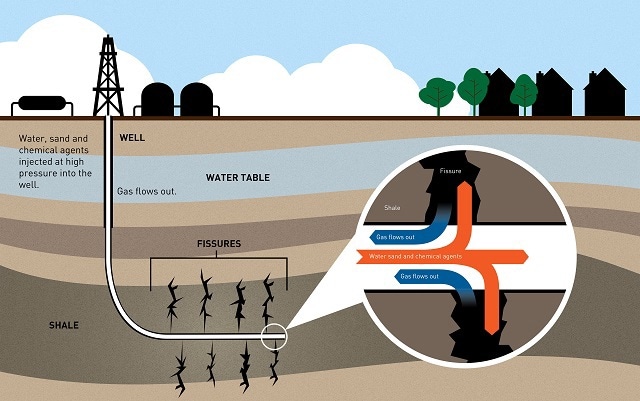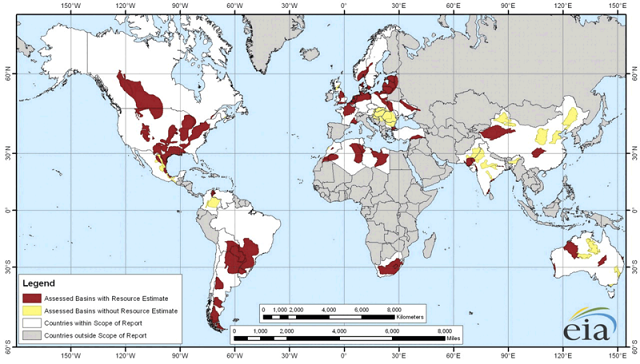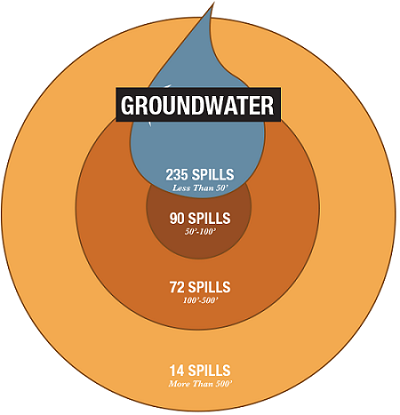
Operating Shale Oil Well. Image Credits: Calin Tatu/shutterstock.com
Hydraulic fracturing, or fracking as it is more commonly referred to, is the process by which underground rock is fractured by a highly pressurized fluid containing water, chemicals and sand.
Firstly, the earth is drilled into to reach the area where the shale gas/oil is located. The high pressure mixture is then directed into the rock to liberate the gas/oil so it can flow with ease to the surface to be harvested for energy purposes.
Figure 1 shows a schematic of a typical fracking site. Small fissures are created by which the gas is released and then flows up the pipe tunnelling into the ground and is stored at the surface in containers. The sand ensures that the cracks, once opened, won't then close so that oil and gas can continue to flow for a long time after fracking has been done.
Once the fracking is finished, constructions are removed and the well is sealed. Fracking fluids are then often pumped deep into the ground and stored there indefinitely.

Figure 1. Infographic Showing How Fracking for Shale Gas/Oil Works. Image Credits: jaddingt/shutterstock.com
Each of the gas wells located at a fracking site requires roughly 400 tanker trucks to supply water to and from it and between 5-35 million litres of water is needed for each fracking job. Once at the site, this water is mixed with 150,000 litres of chemicals. These chemicals include; lead, radium, uranium, ethylene glycol, mercury, formaldehyde, methanol and hydrochloric acid, all of which are toxic to humans and wildlife.
There are over 500,000 active fracking sites in the United States of America alone, and according to the U.S Energy Information Administration as of 2013 in the 41 countries outside of the US that they studied there were 95 shale gas basins which could be recoverable. This works out at roughly 7,299 trillion cubic feet of shale gas globally (including the US).

Figure 2. Map of the major shale gas basis all over the world from the EIA report World Shale Gas Resources: An Intial Assessment of 14 Regions Outside the United States. Image Credits: EIA/Wikimedia Commons
China is deemed to have the largest recoverable supply of shale gas (Fig. 2) and a study published by the Baker Institute of Public Policy at Rice University stated that the US and Canada’s increase in shale gas extraction could ensure that Russia and the Persian Gulf do not dominate the European gas market in years to come.
Fracking explained: opportunity or danger
Fracking Explained: Opportunity or Danger
Controversy
Despite the fact that shale gas is found in large quantities globally and could offer a short term solution to burning coal and other harmful, unsustainable resources, it has come under much scrutiny in the US and other countries looking to adopt the technique around the world.
Environmentalists have claimed that during the fracking process, methane gas and the toxic materials used in the fracking fluid can leach into the nearby groundwater and then contaminate the water supply. The water is so badly contaminated, that it cannot even be purified at a water treatment facility.
Less than half of the chemical mixtures used in the fracking fluid are actually recovered and the chemicals are not biodegradable. According to DangersOfFracking.com, the concentration of methane in drinking water in wells extracted from groundwater nearby fracking sites is 17 times higher than wells situated away from them.
These wells are often used for nearby towns and cities and there have been over 1,000 cases documented where a number of serious health concerns have been attributed to the consumption of contaminated water. Even small quantities of the chemicals used in fracking can contaminate millions of gallons of water. However, a lack of long-term studies into the effects of the contaminated water means that nobody truly knows the consequences of it yet.
Volatile Organic Compounds (VOCs), such as 1,2-Dichloroethane, have been found in the waste fluid flow-back in concentrations far higher than are acceptable in terms of drinking water standards.
According to the United States Environmental Protection Agency (EPA), flow-back fluid samples from Texas, US, which were tested for this VOC reported levels 316 times higher than the maximum permitted level in drinking water. The flowback fluids recovered are left in open air pits (frac ponds) above ground to evaporate, allowing VOCs to leach into air as well as water causing further harm to the environmental.
Handling errors also lead to significant environmental concerns for fracking too. During 2014, 712 spills were reported to the Colorado Oil and Gas Conservation Commission. These leaks can occur during transportation, drilling and production activities.
Figures 3 and 4 show the amount of spills in relation to how far they were away from surface water (Fig. 3) and groundwater (Fig. 4). 79 of these spills resulted in the direct contamination of the water supply and 60 spills occurred within 500 feet of a building.

Distance and frequency of spills in relation to surface water. Image Credits: Center for Western Priorities/COGCC

Distance and frequency of spills in relation to groundwater. Image Credits: Center for Western Priorities/COGCC
Aside from water contamination from the toxic chemicals used in fracking, there is also speculation that the fracturing of large underground rocks and the consequential fissures that are created, can cause significant earthquakes.
There has been a spate of earthquakes in Oklahoma, US the rate at which deviates from the typical amount that the area would receive since fracking has begun there. The state recorded 567 earthquakes measuring higher than 3.0 in magnitude during 2014, which is more than in the previous 30 years combined.
Tulsa World reported on January 25th 2015 that the Oklahoma Supreme Court was to be making a decision as to whether two oil and gas companies could be held liable for an earthquake that hit Prague, Oklahoma in 2011 that measured 5.6 in magnitude, with aftershocks registering as high as 4.0.
The case has been supported by a seismologist from the U.S. Geological Survey who found that the Prague tremor had been caused by three specific nearby fracking facilities. No hearing date has been set but if the law suit is successful, it could see a number of fracking facilities in Oklahoma, Arkansas and Texas be abandoned.
Dangers of fracking
Dangers of Fracking
Financial Advantages of Fracking
There is a long list of environmental problems associated with fracking, however there are also a vast number of advantages compared to using conventional fossil fuels. The first being employment; in the US alone 2.1 million jobs have been created as a consequence of the rise of the fracking industry.
The country is also heading towards being almost completely self-sufficient in terms of its energy demands and is now almost producing more oil than it purchases from other nations.
According to Mark J. Perry, a scholar at the American Enterprise Institute and professor of economics at the University of Michigan, the rise of shale oil in the US is set to turn a 40-year decline in their crude oil output around in as little as 5 and a half years. He claims it to be the “most remarkable economic success story in at least a generation, and maybe in all of US history”.
The idea that fracking is happening nearby where you live can be quite harrowing, however the actual length of time spent conducting the hydraulic fracking is only a few days. The process begins with the construction of the well which takes between 50-100 days.
Once the well is finished the fracking begins to open up the fissures underground and this lasts for 2-5 days. When all of this is complete, the well can operate for between 20-40 years extracting shale oil and gas.
Fracking fueling U.S. economic growth
Fracking Fueling U.S. Economic Growth - CNN
A Cracking Future?
Until fracking is categorically proven to be safe, the debate over whether to employ it in countries across the world will rage on. Organisations such as Frack-Off.org.uk in the United Kingdom are working frantically, arranging protests and assisting the setting up of local anti-fracking groups across the country near where sites have been planned.
In January 2015 the Scottish Government announced an indefinite ban on fracking in Scotland showing that protestors voices are being heard:
However, as long as the US is publishing statistics which show that, as a result of fracking for shale oil and gas, they are becoming increasing self-sufficient, then other countries will be sure to follow their lead.
Sources and Further Reading